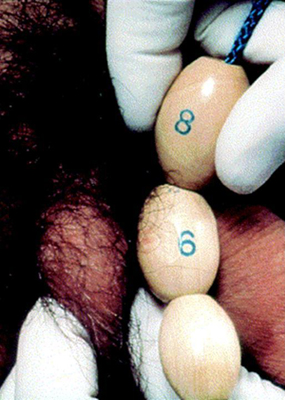Monitoring
All patients need to be monitored during treatment to ensure that puberty is halted. Response to therapy can be assessed clinically by symptoms, the growth velocity, bone age, pubertal progression, measurement of serum gonadotropins and/or sex steroid measurement, or serial ultrasound scans.[82][83]
Growth should be monitored on age- and sex-appropriate growth charts to ensure that the adolescent achieves full growth potential. Continued pubertal assessment is best assessed by Tanner staging.[1][2] Testicular size is documented as a measurement of the longest axis or by the testicular volume using the Prader orchidometer.
[Figure caption and citation for the preceding image starts]: Prader orchidometerCreated by BMJ Knowledge Centre [Citation ends]. [Figure caption and citation for the preceding image starts]: Method of comparing testicular size using the Prader orchidometerFrom the collection of Dr A. Mehta; used with permission [Citation ends].
[Figure caption and citation for the preceding image starts]: Method of comparing testicular size using the Prader orchidometerFrom the collection of Dr A. Mehta; used with permission [Citation ends].
Monitoring of patients with an underlying etiology (e.g., intracranial tumors, McCune-Albright syndrome) will depend upon the individual condition.
Treatment should be stopped once an acceptable age of puberty is reached. Gonadotropin secretion recommences approximately 3 to 4 months after stoppage of treatment, with normal pubertal progress and fertility.
Use of this content is subject to our disclaimer